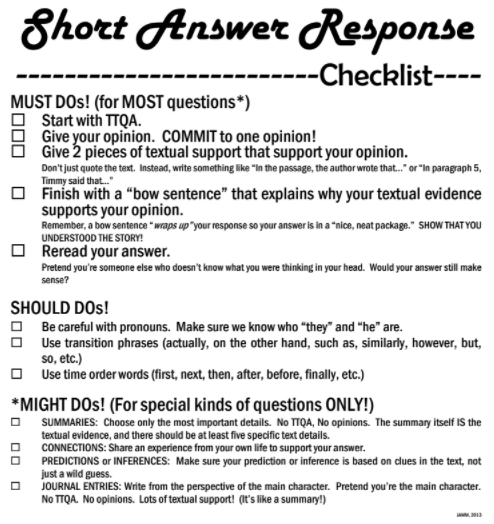Viewing: Google Classroom
November 14, 2018
How Written Responses Are Evaluated
With report cards going live this morning and parent conferences kicking off tomorrow afternoon, I wanted to take a moment to encourage you to visit your child’s Google Classroom page. You’ll need to login with his or her username and password, but the students know that she should always be willing to share their login information with their parents/guardians. On our Google Classroom page, you’ll find much of your child’s written work, including responses to text (check out “A Chair for My Mother SAR”) and descriptive writing (look for the “Summer Snapshot” writing) projects. Feel free to look around, but PLEASE allow your child to do his or her work at school, and please resist the strong urge (Hey, I get it!) to help your child to improve the works-in-progress you see (since I won’t know what’s your child’s work and what is your work).
While not all the documents you’ll come across are intended to be graded (as some are planning tools for other purposes, others are collaborative practice, etc.), those tasks that are assessed are graded within the document itself. All grades and comments from me are written in yellow text, highlighted in black. Bold as that is, it clearly distinguishes my work from your child’s work. (Think of that color pattern as my trademark “teacher’s red pen”, if you will.)
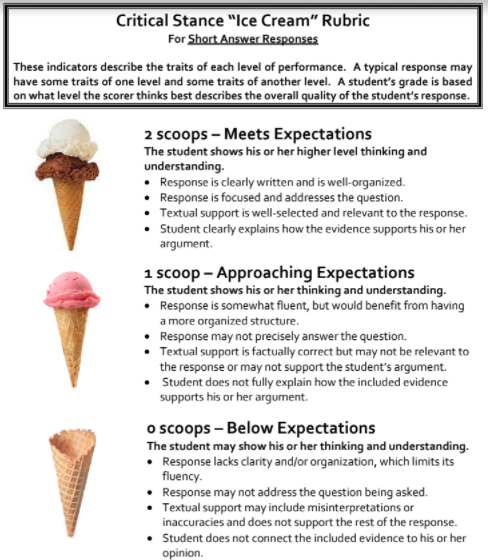 Short answer responses are most typically assessed on a 0-1-2 point scale. Here is a copy of the rubric we use. I want to stress that 0, 1, and 2 should not be converted into a percentage. That is, I’d hate for you to think a score of 1/2 is the same as 50% (a failing grade) or that 2/2 is 100% (perfection). Rather, a 2/2 is a proficient response that includes all the elements I am looking to see. Could it potentially be improved? Of course! A 2/2 doesn’t mean that it’s perfect, just that it met expectations. Likewise, a 1/2 isn’t a failing grade. It means that the student is well on his or her way to developing a successful response, but he or she needs to improve one or more parts of the response in order to reach a 2. When I give a 1, I find myself most often asking students to give more textual support, to select more appropriate textual support, or to focus their response on a single idea and develop that idea more thoroughly. You’ll always see comments from me to explain why your child received the score he or she did.
Short answer responses are most typically assessed on a 0-1-2 point scale. Here is a copy of the rubric we use. I want to stress that 0, 1, and 2 should not be converted into a percentage. That is, I’d hate for you to think a score of 1/2 is the same as 50% (a failing grade) or that 2/2 is 100% (perfection). Rather, a 2/2 is a proficient response that includes all the elements I am looking to see. Could it potentially be improved? Of course! A 2/2 doesn’t mean that it’s perfect, just that it met expectations. Likewise, a 1/2 isn’t a failing grade. It means that the student is well on his or her way to developing a successful response, but he or she needs to improve one or more parts of the response in order to reach a 2. When I give a 1, I find myself most often asking students to give more textual support, to select more appropriate textual support, or to focus their response on a single idea and develop that idea more thoroughly. You’ll always see comments from me to explain why your child received the score he or she did.
How does your child know what goes into a 2/2 response? Good question! In our class, we use a short answer response (SAR) checklist to help students know what a thorough response looks like. Pictured to the right, this checklist lets students organize their writing. Your child should be able to explain to you what things like TTQA and “bow sentences” are.
Other areas, such as organization, sentence structure, grammar, capitalization and punctuation, and spelling are assessed using our report card scale: EMAB. A score of M is most common, indicating that a student is meeting grade-level expectations. An E means that a student has exceeded my grade level expectations. It’s important for you to understand that I don’t look at an M as falling short of earning an E, even though many families tend to feel this way. When a student’s work goes above and beyond and shows a particularly sophisticated application of the concept or skill, he or she may earn an E. Parents often ask “What does my child need to do to earn an E?” That’s really hard to answer. Allow me to provide an example. Imagine a student wrote the following description of our classroom:
There are homemade posters, called anchor charts, hanging all over from lessons. They help us to remember what Mr. Moss taught us. There are also book boxes that alternate in color between yellow and green. These hold all the great books that we get from our class library, school library, or from home. The colorful paper lanterns add even more color to our classroom.
That was a perfectly good description of our classroom, and if I was assessing the response’s sentence structure, it would earn an M. Now compare it to this response:
In our classroom, homemade posters hang all over. Called anchor charts, these tools help us to remember what Mr. Moss has taught us. The yellow and green book boxes add a splash of color to the room, as do the hanging colorful paper lanterns.
It’s clear that this second passage is a more sophisticated style of writing, and it’s sentence structure grade would be an E. But if a parent were to ask me what their student (writer of the first response) needs to do to improve, I’d have a hard time explaining it. The growth comes naturally, as a student becomes a more mature writer. As their overall use of the written English language matures, so will these discrete sentences. It’s the same with word choice. I’d hate for a parent of a student earning an M for word choice to have their child study new vocabulary words with the specific goal of earning a better grade. Instead, as the child reads more mature books with more mature word choices, it’s reasonable to expect that their lexicon will continue to grow and develop.
A grade of A means that a child is approaching the goal, is continuing to work to develop his or her skills in a given area, and has more work to do before reaching goal. An A isn’t a disaster. While I do want to avoid seeing too many A’s in a student’s work, it can serve as a focus area for your child (and perhaps for you, as you work to support your child). Finally a B means that your child’s work is below expectations and that he or she has plenty of room to grow.
I look forward to answering any of your questions about this when we meet for parent-teacher conferences. But in anticipation of our upcoming conversation, please take a moment to look at your child’s Google Classroom page so you are best informed of his or her progress in class.
Posted in Class Updates|By Jon Moss
November 9, 2017
How Written Responses are Assessed
With report cards coming home in about a week, I wanted to take a moment to encourage you to visit your child’s Google Classroom page. You’ll need to login with his or her username and password, but the students know that she should always be willing to share their login information with their parents/guardians. On our Google Classroom page, you’ll find much of your child’s written work, including responses to text (check out “A Chair for My Mother SAR”) and descriptive writing (look for the “Summer Snapshot” writing) projects. Feel free to look around, but PLEASE allow your child to do his or her work at school, and please resist the strong urge (Hey, I get it!) to help your child to improve the works-in-progress you see (since I won’t know what’s your child’s work and what is your work).
While not all the documents you’ll come across are intended to be graded (as some are planning tools for other purposes, others are collaborative practice, etc.), those tasks that are assessed are graded within the document itself. Any grades and comments are written in yellow text, highlighted in black. Bold as that is, it clearly distinguishes my work from your child’s work. (Think of that color pattern as my trademark “teacher’s red pen”, if you will.)
 Short answer responses are most typically assessed on a 0-1-2 point scale. Here is a copy of the rubric we use. I want to stress that 0, 1, and 2 should not be converted into a percentage. That is, I’d hate for you to think a score of 1/2 is the same as 50% (a failing grade) or that 2/2 is 100% (perfection). Rather, a 2/2 is a proficient response that includes all the elements I am looking to see. Could it potentially be improved? Of course! A 2/2 doesn’t mean that it’s perfect, just that it met expectations. Likewise, a 1/2 isn’t a failing grade. It means that the student is well on his or her way to developing a successful response, but he or she needs to improve one or more parts of the response in order to reach a 2. When I give a 1, I find myself most often asking students to give more textual support, to select more appropriate textual support, or to focus their response on a single idea and develop that idea more thoroughly. You’ll always see comments from me to explain why your child received the score he or she did.
Short answer responses are most typically assessed on a 0-1-2 point scale. Here is a copy of the rubric we use. I want to stress that 0, 1, and 2 should not be converted into a percentage. That is, I’d hate for you to think a score of 1/2 is the same as 50% (a failing grade) or that 2/2 is 100% (perfection). Rather, a 2/2 is a proficient response that includes all the elements I am looking to see. Could it potentially be improved? Of course! A 2/2 doesn’t mean that it’s perfect, just that it met expectations. Likewise, a 1/2 isn’t a failing grade. It means that the student is well on his or her way to developing a successful response, but he or she needs to improve one or more parts of the response in order to reach a 2. When I give a 1, I find myself most often asking students to give more textual support, to select more appropriate textual support, or to focus their response on a single idea and develop that idea more thoroughly. You’ll always see comments from me to explain why your child received the score he or she did.
How does your child know what goes into a 2/2 response? Good question! In our class, we use a short answer response (SAR) checklist to help students know what a thorough response looks like. Pictured to the right, this checklist lets students organize their writing. Your child should be able to explain to you what things like TTQA and “bow sentences” are.
Other areas, such as organization, sentence structure, grammar, capitalization and punctuation, and spelling are assessed using our report card scale: EMAB. A score of M is most common, indicating that a student is meeting grade-level expectations. An E means that a student has exceeded my grade level expectations. It’s important for you to understand that I don’t look at an M as falling short of earning an E, even though many families tend to feel this way. When a student’s work goes above and beyond and shows a particularly sophisticated application of the concept or skill, he or she may earn an E. Parents often ask “What does my child need to do to earn an E?” That’s really hard to answer. Allow me to provide an example. Imagine a student wrote the following description of our classroom:
There are homemade posters, called anchor charts, hanging all over from lessons. They help us to remember what Mr. Moss taught us. There are also book boxes that alternate in color between yellow and green. These hold all the great books that we get from our class library, school library, or from home. The colorful paper lanterns add even more color to our classroom.
That was a perfectly good description of our classroom, and if I was assessing the response’s sentence structure, it would earn an M. Now compare it to this response:
In our classroom, homemade posters hang all over. Called anchor charts, these tools help us to remember what Mr. Moss has taught us. The yellow and green book boxes add a splash of color to the room, as do the hanging colorful paper lanterns.
It’s clear that this second passage is a more sophisticated style of writing, and it’s sentence structure grade would be an E. But if a parent were to ask me what their student (writer of the first response) needs to do to improve, I’d have a hard time explaining it. The growth comes naturally, as a student becomes a more mature writer. As their overall use of the written English language matures, so will these discrete sentences. It’s the same with word choice. I’d hate for a parent of a student earning an M for word choice to have their child study new vocabulary words with the specific goal of earning a better grade. Instead, as the child reads more mature books with more mature word choices, it’s reasonable to expect that their lexicon will continue to grow and develop.
A grade of A means that a child is approaching the goal, is continuing to work to develop his or her skills in a given area, and has more work to do before reaching goal. An A isn’t a disaster. While I do want to avoid seeing too many A’s in a student’s work, it can serve as a focus area for your child (and perhaps for you, as you work to support your child). Finally a B means that your child’s work is below expectations and that he or she has plenty of room to grow.
I look forward to answering any of your questions about this when we meet for parent-teacher conferences. But in anticipation of our upcoming conversation, please take a moment to look at your child’s Google Classroom page so you are best informed of his or her progress in class.
Posted in Class Updates|By Jon Moss
September 28, 2016
Our first writing piece!
We’ve finished our first writing piece of fourth grade! For the past few weeks, we’ve been working on a descriptive writing assignment in which students had to choose a single moment from their summers. This one moment was turned into a snapshot, as if someone paused a video at one split second. (Still photos are “SO” 1996… :-D) Students brainstormed details from this memory and completed a graphic organizer in which they listed details for their SEVEN senses of writing: the traditional sight, sound, touch, taste, and smell, along with both thoughts and feelings. Over the past week, we also worked on enriching their word choice (remember those Wordstorm packets from last week’s homework?) and adding similes to better describe valuable details. Finally, students pulled all these pieces together to draft their descriptions, and they self-revised and self-edited their work before doing both with a partner as well. (Ask you child what the difference is between revising and editing, and ask them which you should always do first!)
Over the past few days, I reviewed each student’s work and provided some feedback to them in their Google Doc. As I shared at open house, you should ALWAYS have access to your children’s Google Classroom account (with their username and password) so you can review their work and my feedback. All I ask is that you DON’T make any changes to their work. I know families come with the best of intentions, but even the most well-intentioned edits and revisions cansidetrack plans I have for lessons or activities. Additionally, it’s important that when I review a student’s work, I know that I’m reading their own work, not something edited or otherwise supported by a grown-up at home. I appreciate you saving that for in-school, unless a specific assignment asks them to work with you at home.
This assignment, which you’ll find under the “Brainstorming Summer Memory” activity, was assessed using our snapshot writing rubric. At the end of your student’s response, you’ll find my comments along with my scores. In each of the seven areas, your child was evaluated on the same four-point scale we use on the report card: An E reflects work that exceeds my expectations for a fourth grader at THIS POINT of the school year. An M reflects that the student’s work meets expectations, while an A indicates that the work is approaching expectations and needs continued growth. A score of B indicates that the work is below expectations and that we’ll continue to work together to improve in this area. We discussed this in class, and your fourth grader can help you to understand each of the areas I assessed.
In class today, we discussed the kind of feedback I gave (often having to do with focusing on a single moment and not a series of events, addressing run-on sentences, adding details to better describe the seven senses, etc.), and most students identified specific ways in which they wanted to improve their writing. This piece was a learning activity in which the students worked with me and with each other throughout the process. Today, students begun writing their family snapshot (as opposed to their summer snapshots). This piece of writing is very similar, but it focuses on a different memory than the summer snapshot. Additionally, this is a wholly independent piece. Students were given the same graphic organizer, editing and revising venn diagram, and Wordstorm lists to help them, but they’re independently moving through the process of developing their response.
We’re just starting this project, so I appreciate you letting your child move through this part themselves. But I encourage you to review your student’s Summer Snapshot project with your child! Keep an eye on their Google Classroom page for more work as the year goes on, and feel free to contact me with any questions!
Interested in learning more about Google Classroom? This video is a bit old, but it’s a terrific introduction to the platform!
Posted in Class Updates|By Jon Moss
March 2, 2016
Where is your child’s work and grades?
It wasn’t so long ago that parents could open their child’s homework folder and find corrected language arts work coming home on a regular basis. These reading and writing exercises had teacher comments and a grade, and parents could see what their child was working on in school. This year, those same opportunities exist, but it’s all online now. When we met for December parent-teacher conferences, I discussed Google Classroom with many families. With our next round of conferences coming later this month, I thought this would be a good time to remind you of this wonderful resource.
Google Classroom is a core part of Google Apps for Education. Think of it as a learning management system that allows me to share resources, distribute files, assign tasks, and allows students students to complete and submit tasks, receive feedback, discuss ideas with peers, and more. (The short video above, while slightly out of date, does a great job of showing what Google Classroom can do.)
Nearly ALL of your child’s written work is completed on a Chromebook, within Google Classroom. Parents of PGS fourth graders should ALWAYS be able to access their child’s Google Classroom account (using their child’s username and password, which should always be shared with parents). To login, visit classroom.google.com and log in with your child’s username and password. There, you’ll find a lot of your forth grader’s work, along with my feedback and grades. Sometimes grades may be posted in the Google Classroom assignment section, but I often put grades within the student’s document itself. I encourage you to check Google Classroom on a periodic basis, although the one thing I ask is that you NOT make revisions to your child’s work without checking with me. A lot of what you’ll find is a work-in-progress, and it’s important that students have the opportunity to learn by working through a process, rather than having corrections made by an adult at home. (Remember, you’re logging in as your fourth grader, not under some separate parent account. So there’s no way for me to distinguish work your child does from revisions you may make.)
If you have any questions, please feel free to contact me.
Posted in Class Updates|By Jon Moss
August 28, 2015
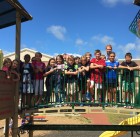
Happy Friday!
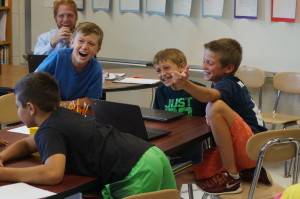 We have started off the year with three terrific days in room 209! The start of school can be a challenging transition for students, and Mr. Walmer and I have worked hard to make our classroom a welcoming community for all 22 new fourth graders. Of course, we did the usual activities with learning classroom routines, students attended their first music, library, Spanish, and wellness classes, and we participated in our school’s traditional first day bell-ringing ceremony. I’d like to take the opportunity to share with you four other activities we’ve been working on this week.
We have started off the year with three terrific days in room 209! The start of school can be a challenging transition for students, and Mr. Walmer and I have worked hard to make our classroom a welcoming community for all 22 new fourth graders. Of course, we did the usual activities with learning classroom routines, students attended their first music, library, Spanish, and wellness classes, and we participated in our school’s traditional first day bell-ringing ceremony. I’d like to take the opportunity to share with you four other activities we’ve been working on this week.
Social Contract
In lieu of class rules, we have worked together to brainstorm ways we want to be treated. Specifically, students answered four questions:
- How do we want to be treated by our teachers?
- How do our teachers want to be treated by us?
- How do we want to treat each other?
- How do we want to treat each other when there is a conflict?
In answering these questions, students generated lists of ideas that describe how we should treat others in the classroom. Some words/phrases, such as “respectfully” and “fairly” appeared as answers to multiple questions, so these will likely be emphasized in our final social contract (which I hope to finish early next week). The social contract is a terrific resource, because we all hold one another accountable to fulfill what we agree to do (when we all sign it.) So if a student is, for example, disturbing others during a lesson, I can refer back to the social contract by saying something like “Hey, Timmy, when you signed the social contract, you agreed to be helpful. When you’re making funny faces, are you helping your classmates to learn? You also promised to be respectful to others. I’ve asked you a few times to focus on the lesson, and I noticed that your friend asked you not to distract her as well. Are you respecting your friend and me when you keep doing that?” Using the social contract helps students to adjust their choices and see why poor choices affect others negatively, rather than just “getting in trouble.”
Chromebooks and Google Classroom
I love using technology in our classroom when it allows students to interact or think at a deeper level, when it makes some of our classroom processes more efficient, or when it is a motivator to students. Yesterday, students got their first opportunity of the year to work on Chromebooks and to log into our Google Classroom page. Kids completed an exercise to prepare for our Two Truths and a Lie activity (see below), and today, students started writing letters to their future selves (at the end of this year) about their goals, predictions, worries, and hopes for the year to come. I’ll share a lot more information with you in the coming weeks, but in the interest of clarity please note that (a) students should always share their Google login information with their grownups at home, and (b) students should NOT be using their school Google email accounts at all right now.
Two Truths and a Lie
Yesterday, students wrote th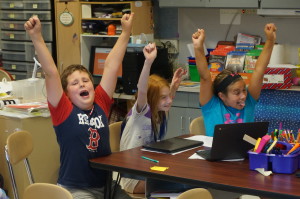 ree statements about themselves in a Google Doc activity; two of the statements were true, and one was a lie. Last night, I imported those statements into a game environment called Kahoot, which creates a quiz game based on the content I import. We played this game this afternoon, and the kids really
ree statements about themselves in a Google Doc activity; two of the statements were true, and one was a lie. Last night, I imported those statements into a game environment called Kahoot, which creates a quiz game based on the content I import. We played this game this afternoon, and the kids really 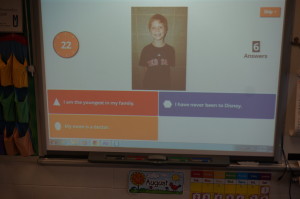 enjoyed learning more about their classmates in a fun and unique way! Plus, the gameshow-like interface of Kahoot created a friendly competition in our classroom. We’ll definitely use this tool more in the future!
enjoyed learning more about their classmates in a fun and unique way! Plus, the gameshow-like interface of Kahoot created a friendly competition in our classroom. We’ll definitely use this tool more in the future!
Readers’ Workshop
Reading lessons started on Thursday! In fourth grade, our reading instruction is inspired by Readers’ Workshop, which is an instructional philosophy that the best literacy instruction is delivered in small bundles, with plenty of opportunity to practice skills as a whole class, in small groups, and individually. Our lessons started with an introduction to our classroom library and book bins, and continued today with a lesson about what silent reading should look like and sound like.
Alliterative Adjective Greetings
You may have noticed that your son or daughter came home on Wednesday with an assignment to think of an adjective that either starts with the same letter as his or her first name and/or with the same sound as his or her first name. Today, students greeted their classmates at their table groups with their nicknames, and we added some challenge by asking students to race to pass around a foam ball while greeting their table-mates, sometimes while skipping around!
Posted in Class Updates|By Jon Moss

